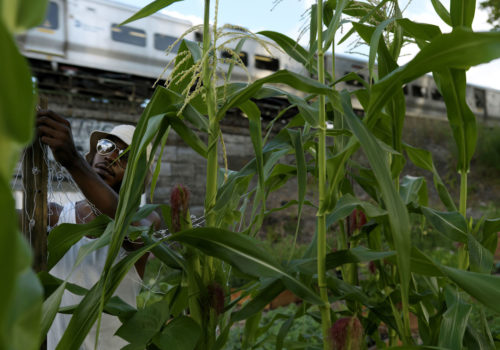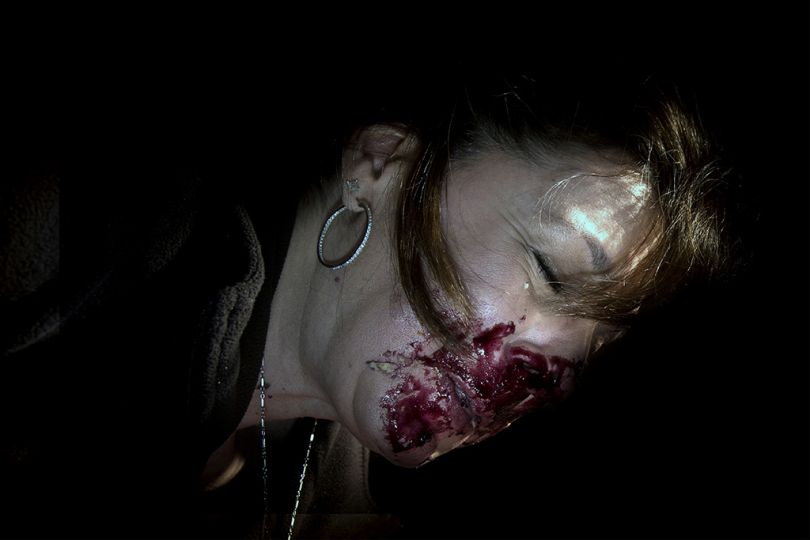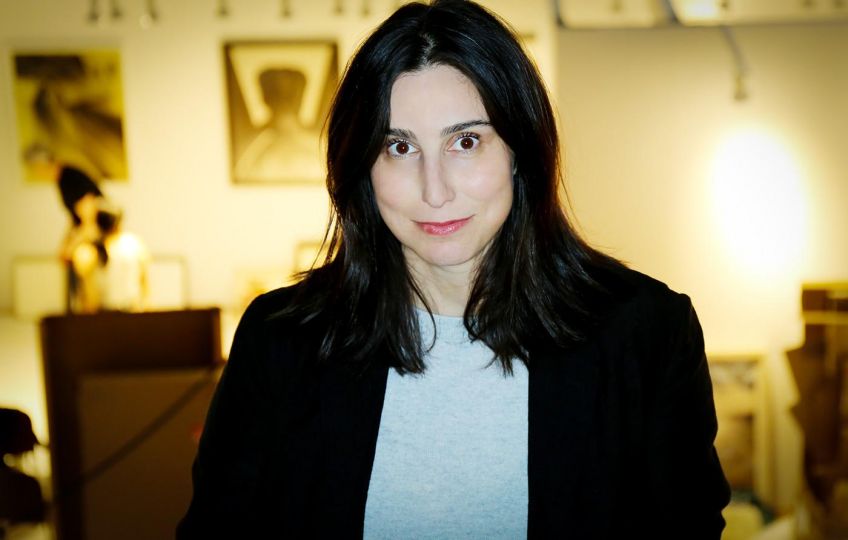A Conversation with Photographer Nina Berman— Bryant Park, New York, June 2012
Pauline Vermare — A week after Memorial Day, your essays Purple Hearts and Marine Wedding both resonate in a very dark and timely manner. What led you to these stories?
Nina Berman – At first, it became just an outlet for me to oppose what I saw in the mainstream media, which was the lead up to the Iraq war. I remember in 2002, in December, I was shooting something at the White House – I forget what it was – and I saw all the press core getting ready to outfit themselves for the war, and I thought, “What is happening? Could this really be unfolding?” And then when the war began in March 2003 and the press coverage was very much a kind of Hollywood extravaganza — or so it appeared on television — I felt lied to and I felt like I needed to find some way to personally counter this and to engage in this war beyond just watching it on television. You could see pretty early on that there wasn’t going to be any visual recording of wounded or killed, either Iraqi or American, and yet you would read about, you know, “three wounded today,” and I wanted to know, “what does that mean, to be wounded? And maybe that’s something I could do.” And so I just went looking for these subjects. And then I became much more interested in the whole aspect of what does it mean when you are a young person and you dedicate yourself to what you think is your perfect dream, that it’s going to get you out of your life, and then at a moment that’s not of your choosing you are completely ripped back into you old life. And then there are a lot of other elements adding to it: joining the military because you are poor, or joining the military because you are patriotic, and what does that mean?
PV : Would you call yourself a photojournalist?
NB : I came to photography late, round 28, that’s considered ancient now… My dream was to be a writer, really. And because the American culture sees this word “photojournalist” in a certain way, I pulled back from it. I very much want to bring my personal ideas into my pictures, I don’t’ believe in this idea of the objective viewer — and I don’t practice this kind of fast-paced ‘photography of the moment.’ Most people see photojournalists as combat photographers or paparazzi. And I am neither one. So I just call myself a “photographer”.
PV : Where did you grow up?
NB : I first grew up in the Bronx, and then at age 8 we moved to the suburbs, in New Jersey.
PV : And what do you think in your upbringing or personality made you do what you are doing?
NB : I wondered about that. I have this memory, at an early age, and maybe for other people that might be an irrelevant thought, but I remember as a young child watching with my parents the Republican convention on television, with Nixon and Agnew in 1968. I must have been 8 and I remember seeing the images on TV and thinking it was spectacular and being really kind of seduced by the imagery and the flags waving and people clapping and smiling; and then when it was over, my parents were stone-faced, and I remember feeling strangely uncomfortable about this; my father was steaming and my mother started cursing. And I thought, now how is this? I look at something, and it looks so great to me, but then my parents who I trust think that it’s horrible? I can remember the whole scene – and it’s wasn’t even so much about “Nixon is a bad guy” or “Agnew is a bad guy,” it was just this idea of looking at something and thinking it’s fantastic, and then realizing that no, there is actually something quite insidious and negative about it. And so I think in some ways that made me very visually critical about the world around me: “what is it I am looking at and am I being manipulated? Am I being played, somehow?”
And then in terms of veterans, when I went to college, I met my first Vietnam veterans; one of them was a bartender, and he used to say late at night: “Oh they had the most beautiful women in the world, and all we did was kill them.” And I remember him, as well as another guy, who was totally traumatized, and whenever he heard a gunshot in the neighborhood he would hit the ground. And I thought, clearly, these were very tortured persons, and what was it that happened to them or that they did? And so when I was a reporter, one of the major stories I did was I traveled with a group of Vietnam veterans, early on, in 1987, back to Vietnam, and so I saw the psychological effects, and how war is not something that just happens on the battlefields and then goes away. So I think meeting these Iraq vets was a way for me to more fully explore photographically what I had started to explore as a writer.
PV : Any influences, or photographers whose work inspired you?
NB : I think the one that smacked me in the face early on was Diane Arbus. She was the first photo book I ever saw in my life and it was like my world exploded just by looking at it: wow, wow, wow! You would look at these very conventional people on the surface, they appeared conventional, and there was something so strange — an underlying current of either hostility or some sinister quality… And then the freaks just seemed completely affable and lovable to me. She was someone that I always loved. Beyond that, I really can’t point at so many people.
PV : Is that beautiful series you made — Obama train — a tribute to Paul Fusco’s RFK funeral train?
NB : Oh totally. These are some of my favorite pictures of all times, they are gorgeous. I wanted to go on the train, thinking that it was going to be like the RFK train. And then I get on the train and I realize that everything is hermetically sealed because of course we live in this age where the president lives in a bubble. And really you are a trapped person in the train and I never saw Obama –you’d see flickers of people. And I wasn’t sure what I was photographing, what I was making while I was shooting, but at the end when I looked at it, I saw it as kind of more broken than hopeful, because the colors are all brownish and the landscape is pretty broken up.
PV : There is a certain melancholy in the train passing by.
NB : Absolutely. And then there was a fear that somebody was going to kill him before the inauguration. This was two days before. And so there was a lot of fear that he would never get there. So there are pictures of the police, kind of lurking there. Anyway, I like these pictures a lot and I’m glad that they started being exhibited, only really in Europe. Here, nothing ever happened to them…
PV : Do you feel more at ease with color or black & white?
NB : Color –because it’s much harder. I think that black and white is actually much easier, and so for me the color is a challenge: so much can go wrong, so many variable elements can come into play that can really wreck a picture; and also, the color can provide all of these different sources of emotion.
PV : In Homeland, you depict America’s rising militarization following 9/11. Could you tell me more about two powerful images in this corpus –first, the little boys and the American flag?
NB : It was on July 4th in a little town in New Jersey. This is before a tiny parade begins and they’re just organizing themselves in the street and they are going to bike to the parade. They appeared to me like a gang, with their colors and hostility. I find that little boy very scary, I don’t think that he is scary at all but that’s how pictures lie or how they communicate something beyond what’s there.
PV : And how about the man lying under a fence? Quite an arresting picture.
NB : It’s crazy isn’t it? It’s totally crazy. These are swat police: American police have become much more militarized since the war on drugs and now the war on terror, and once a year hundreds of them get together in this place in Florida and they practice with live ammunition. They do all these things. So this is actually an obstacle course, and they are crawling on their back, underneath this fence, and this is a pit of mud, and they have to come out and then they run and do something else. It’s a whole business. And so as I am making this picture, I am standing there on top of the fence right over his face – you can see this is not a long lens – and I realize that they look like they’re being tortured, right? I see myself as a journalist but all of these other things that come into my pictures, I hope other people get something from, they are really like conversations with myself and my memories. This to me looks like “wow, it looks like he could be in Guantanamo”. They look like they are being tortured, like they’re going to die. And in fact, he could look like he’s dead.
PV : How do you use photography for yourself?
NB : Well, I’m a very politically minded person, I want to be part of this political conversation that’s happening in the United States; and I read all these stories, like so many of us do, or see pictures, and how do you process them? And so in some ways I process them by taking new pictures, and so how do you deal with this concept of Guantanamo? And then later on it comes out and you see something and you think, “Holy shit!” and it sparks something and then you make a picture and you feel like somehow then you understand the conversation better. Maybe it allows me some closure in some of my thoughts.
PV : Your series on religious fanaticism in the US, Megachurches, is fascinating. How about that surreal photograph of the broken God-all-mighty?
NB : It was struck by lightning! Literally, it burnt down. It was in Ohio. What’s interesting is that I took different pictures of the same statue at different times during the day, and this one is very sinister and spooky, then you have one where it looks so ridiculous and campy, and small… So what’s the ‘real’ one? It just depends on what idea you want to convey. This concept that there is some objectivity is just insane.
I’m actually about to go back to this subject a little bit. Such a religious country, people don’t understand. I now really want to look into this idea of religion and homosexuality in the US. So I’ll be going to North Carolina next month, so much is going on. There you have some of the most violent condemnations of homosexuality. And then you have very many religious homosexuals too. And so how does someone navigate these two worlds? I’m very interested in religious and political ideology, how that restricts or emboldens an individual. I have now been shooting many stories and I see somewhat of a circle: North Carolina has two of the biggest military bases in the US. with the whole ‘don’t ask don’t tell’ mentality. Then you have the whole masculinization of the Christ figure, this would never play in European Catholicism, this image. The Christ has become a warrior figure. And so the idea of the man is all powerful—no vulnerabilities. The idea of two men being sensitive with each other is just impossible.
The gay rights movement had not interested me before. I believe in it, I support it, but I am not gay myself, I don’t’ feel it personally. But now when you see the violence against the idea of people formalizing a relationship, and the language employed,“let’s kill them!”, “let’s beat it out of them!”, it’s really something else going on, rather than “I disagree with homosexuality”… Why is it religious based? Why is it coming from the churches? Here there are all these programs where you can “fix” this person. This is a civil rights issue, and nothing that’s been confronted that way. I will work with a young art professor who is more into video, so the two of us will work together on it.
PV : Would you tell me more about the genesis of the Bronx Documentary Center project?
NB : This was really my way of trying to find enjoyments in New York City again. I lived here so long, and you live in New York you kind of live in your own little quarters — this neighborhood, this coffee shop, these people. And I wanted to break out of my little world, so I started looking at these gardens; I was always attracted, walking by these tangled spaces. So I just started driving around the Bronx, looking, and at the same time, I guess I had just joined Noor, in 2009, and Noor was focused at that point on environmental work, so I started it thinking “this is going to be my own little project – just what I do when I’m in New York and I have nothing else to do”. I never was sure if I could make a beautiful picture, like take something and make it lovely, so I wanted that creative challenge, see if I could do that, and then I just got to really like some of the spaces. So then Noor did this project on climate change so I thought now I’m going to work hard on this Bronx garden thing, and I discovered all these people and I love being in those spaces; and then it became a challenge, to make this tangled up space look gorgeous. It also challenges the idea of what the Bronx is, right? because it’s this idea of “big bad Bronx”, and if you go to the Bronx you’re going to get shot, and so there’s nothing terribly complicated about it but I do like having work that can live in the community, like with Purple Hearts I traveled with the soldiers around the country, and we brought it back to certain places. So the Bronx Documentary Center seems like the perfect place. And if you get up there, you will see– it is such a concrete jungle!
PV : You are going to start teaching at the Columbia University Graduate School of Journalism and help restructure the department; what will your priorities be, message wise, for the students?
NB : Well, because the technology is so easy now, my priority is not in technique. I think that people can take amazing pictures with really simple cameras. And so it’s really going to be about how they think– take what’s here in your head and translate that into an image. And I’m going to be teaching lots of students who may or may not want to become photographers. They may want to be reporters or writers, and yet in terms of the economy today these people will probably likely be taking pictures as well. My whole thing is to show them the rules and then teach them to please break them. Show me something completely original and unexpected if possible. That’s my plan.
Pauline Vermare is a Curatorial Assistant at the Robert Capa Archive, International Center of Photography, New York.
Bronx Garden – Nina Berman
June 2, 2012 – August 16, 2012
Bronx
614 Courtlandt Avenue
(@ 151st St.) Bronx
New York 10451
Obama Train – Nina Berman
through July 8, 2012
at “Making History: Ray 2012”
Frankfurt – Germany

















